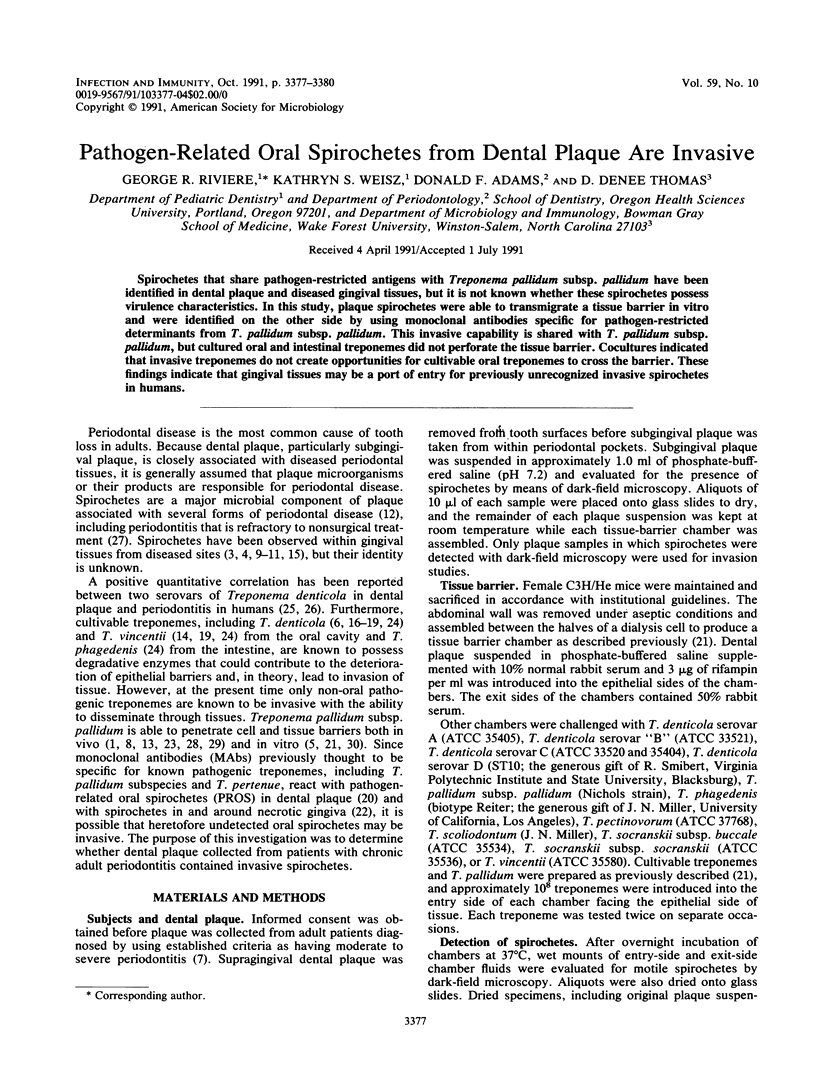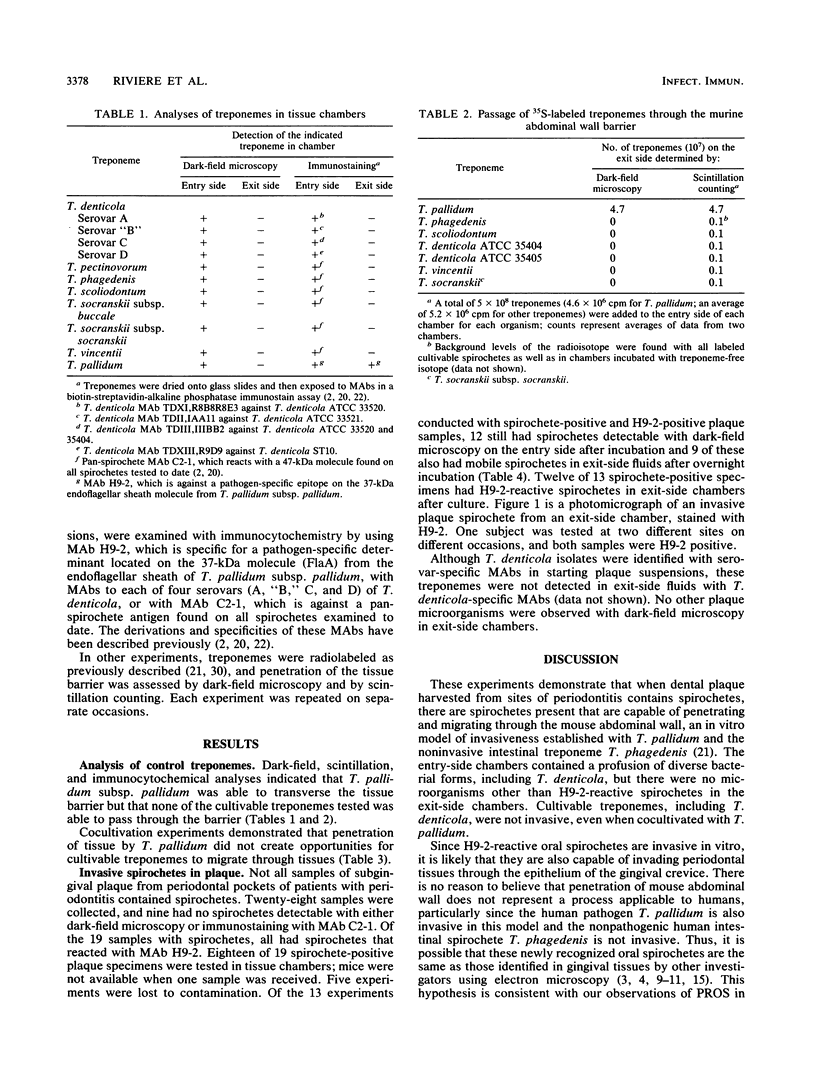Abstract
Spirochetes that share pathogen-restricted antigens with Treponema pallidum subsp. pallidum have been identified in dental plaque and diseased gingival tissues, but it is not known whether these spirochetes possess virulence characteristics. In this study, plaque spirochetes were able to transmigrate a tissue barrier in vitro and were identified on the other side by using monoclonal antibodies specific for pathogen-restricted determinants from T. pallidum subsp. pallidum. This invasive capability is shared with T. pallidum subsp. pallidum, but cultured oral and intestinal treponemes did not perforate the tissue barrier. Cocultures indicated that invasive treponemes do not create opportunities for cultivable oral treponemes to cross the barrier. These findings indicate that gingival tissues may be a port of entry for previously unrecognized invasive spirochetes in humans.
Full text
PDF



Images in this article
Selected References
These references are in PubMed. This may not be the complete list of references from this article.
- Azar H. A., Pham T. D., Kurban A. K. An electron microscopic study of a syphilitic chancre. Engulfment of Treponema pallidum by plasma cells. Arch Pathol. 1970 Aug;90(2):143–150. [PubMed] [Google Scholar]
- Barron S. L., Riviere G. R., Simonson L. G., Lukehart S. A., Tira D. E., O'Neil D. W. Use of monoclonal antibodies to enumerate spirochetes and identify Treponema denticola in dental plaque of children, adolescents and young adults. Oral Microbiol Immunol. 1991 Apr;6(2):97–101. doi: 10.1111/j.1399-302x.1991.tb00458.x. [DOI] [PubMed] [Google Scholar]
- Carranza F. A., Jr, Saglie R., Newman M. G., Valentin P. L. Scanning and transmission electron microscopic study of tissue-invading microorganisms in localized juvenile periodontitis. J Periodontol. 1983 Oct;54(10):598–617. doi: 10.1902/jop.1983.54.10.598. [DOI] [PubMed] [Google Scholar]
- Courtois G. J., 3rd, Cobb C. M., Killoy W. J. Acute necrotizing ulcerative gingivitis. A transmission electron microscope study. J Periodontol. 1983 Nov;54(11):671–679. doi: 10.1902/jop.1983.54.11.671. [DOI] [PubMed] [Google Scholar]
- Fitzgerald T. J., Johnson R. C., Miller J. N., Sykes J. A. Characterization of the attachment of Treponema pallidum (Nichols strain) to cultured mammalian cells and the potential relationship of attachment to pathogenicity. Infect Immun. 1977 Nov;18(2):467–478. doi: 10.1128/iai.18.2.467-478.1977. [DOI] [PMC free article] [PubMed] [Google Scholar]
- Grenier D., Uitto V. J., McBride B. C. Cellular location of a Treponema denticola chymotrypsinlike protease and importance of the protease in migration through the basement membrane. Infect Immun. 1990 Feb;58(2):347–351. doi: 10.1128/iai.58.2.347-351.1990. [DOI] [PMC free article] [PubMed] [Google Scholar]
- Kornman K. S. Nature of periodontal diseases: assessment and diagnosis. J Periodontal Res. 1987 May;22(3):192–204. doi: 10.1111/j.1600-0765.1987.tb01566.x. [DOI] [PubMed] [Google Scholar]
- LISTGARTEN M. A. ELECTRON MICROSCOPIC OBSERVATIONS ON THE BACTERIAL FLORA OF ACUTE NECROTIZING ULCERATIVE GINGIVITIS. J Periodontol. 1965 Jul-Aug;36:328–339. doi: 10.1902/jop.1965.36.4.328. [DOI] [PubMed] [Google Scholar]
- LISTGARTEN M. A., SOCRANSKY S. S. ELECTRON MICROSCOPY AS AN AID IN THE TAXONOMIC DIFFERENTIATION OF ORAL SPIROCHETES. Arch Oral Biol. 1965 Jan-Feb;10:127–138. doi: 10.1016/0003-9969(65)90064-6. [DOI] [PubMed] [Google Scholar]
- Lauderdale V., Goldman J. N. Serial ultrathin sectioning demonstrating the intracellularity of T. Pallidum. An electron microscopic study. Br J Vener Dis. 1972 Apr;48(2):87–96. doi: 10.1136/sti.48.2.87. [DOI] [PMC free article] [PubMed] [Google Scholar]
- Loesche W. J. The role of spirochetes in periodontal disease. Adv Dent Res. 1988 Nov;2(2):275–283. doi: 10.1177/08959374880020021201. [DOI] [PubMed] [Google Scholar]
- Manor A., Lebendiger M., Shiffer A., Tovel H. Bacterial invasion of periodontal tissues in advanced periodontitis in humans. J Periodontol. 1984 Oct;55(10):567–573. doi: 10.1902/jop.1984.55.10.567. [DOI] [PubMed] [Google Scholar]
- Mikx F. H., de Jong M. H. Keratinolytic activity of cutaneous and oral bacteria. Infect Immun. 1987 Mar;55(3):621–625. doi: 10.1128/iai.55.3.621-625.1987. [DOI] [PMC free article] [PubMed] [Google Scholar]
- Mäkinen K. K., Syed S. A., Loesche W. J., Mäkinen P. L. Proteolytic profile of Treponema vincentii ATCC 35580 with special reference to collagenolytic and arginine aminopeptidase activity. Oral Microbiol Immunol. 1988 Sep;3(3):121–128. doi: 10.1111/j.1399-302x.1988.tb00096.x. [DOI] [PubMed] [Google Scholar]
- Nitzan D., Sperry J. F., Wilkins T. D. Fibrinolytic activity of oral anaerobic bacteria. Arch Oral Biol. 1978;23(6):465–470. doi: 10.1016/0003-9969(78)90078-x. [DOI] [PubMed] [Google Scholar]
- Ohta K., Makinen K. K., Loesche W. J. Purification and characterization of an enzyme produced by Treponema denticola capable of hydrolyzing synthetic trypsin substrates. Infect Immun. 1986 Jul;53(1):213–220. doi: 10.1128/iai.53.1.213-220.1986. [DOI] [PMC free article] [PubMed] [Google Scholar]
- Reijntjens F. M., Mikx F. H., Wolters-Lutgerhorst J. M., Maltha J. C. Adherence of oral treponemes and their effect on morphological damage and detachment of epithelial cells in vitro. Infect Immun. 1986 Feb;51(2):642–647. doi: 10.1128/iai.51.2.642-647.1986. [DOI] [PMC free article] [PubMed] [Google Scholar]
- Riviere G. R., Thomas D. D., Cobb C. M. In vitro model of Treponema pallidum invasiveness. Infect Immun. 1989 Aug;57(8):2267–2271. doi: 10.1128/iai.57.8.2267-2271.1989. [DOI] [PMC free article] [PubMed] [Google Scholar]
- Riviere G. R., Weisz K. S., Simonson L. G., Lukehart S. A. Pathogen-related spirochetes identified within gingival tissue from patients with acute necrotizing ulcerative gingivitis. Infect Immun. 1991 Aug;59(8):2653–2657. doi: 10.1128/iai.59.8.2653-2657.1991. [DOI] [PMC free article] [PubMed] [Google Scholar]
- Sell S., Gamboa D., Baker-Zander S. A., Lukehart S. A., Miller J. N. Host response to Treponema pallidum in intradermally-infected rabbits: evidence for persistence of infection at local and distant sites. J Invest Dermatol. 1980 Dec;75(6):470–475. doi: 10.1111/1523-1747.ep12524230. [DOI] [PubMed] [Google Scholar]
- Siboo R., al-Joburi W., Gornitsky M., Chan E. C. Synthesis and secretion of phospholipase C by oral spirochetes. J Clin Microbiol. 1989 Mar;27(3):568–570. doi: 10.1128/jcm.27.3.568-570.1989. [DOI] [PMC free article] [PubMed] [Google Scholar]
- Simonson L. G., Goodman C. H., Bial J. J., Morton H. E. Quantitative relationship of Treponema denticola to severity of periodontal disease. Infect Immun. 1988 Apr;56(4):726–728. doi: 10.1128/iai.56.4.726-728.1988. [DOI] [PMC free article] [PubMed] [Google Scholar]
- Simonson L. G., Goodman C. H., Morton H. E. Quantitative immunoassay of Treponema denticola serovar C in adult periodontitis. J Clin Microbiol. 1990 Jul;28(7):1493–1496. doi: 10.1128/jcm.28.7.1493-1496.1990. [DOI] [PMC free article] [PubMed] [Google Scholar]
- Sykes J. A., Miller J. N. Intracellular location of Treponema pallidum (Nichols strain) in the rabbit testis. Infect Immun. 1971 Sep;4(3):307–314. doi: 10.1128/iai.4.3.307-314.1971. [DOI] [PMC free article] [PubMed] [Google Scholar]
- Söder P. O., Frithiof L., Söder B. Spirochaetes and granulocytes at sites involved in periodontal disease. Arch Oral Biol. 1990;35 (Suppl):197S–200S. doi: 10.1016/0003-9969(90)90157-6. [DOI] [PubMed] [Google Scholar]
- Thomas D. D., Navab M., Haake D. A., Fogelman A. M., Miller J. N., Lovett M. A. Treponema pallidum invades intercellular junctions of endothelial cell monolayers. Proc Natl Acad Sci U S A. 1988 May;85(10):3608–3612. doi: 10.1073/pnas.85.10.3608. [DOI] [PMC free article] [PubMed] [Google Scholar]



